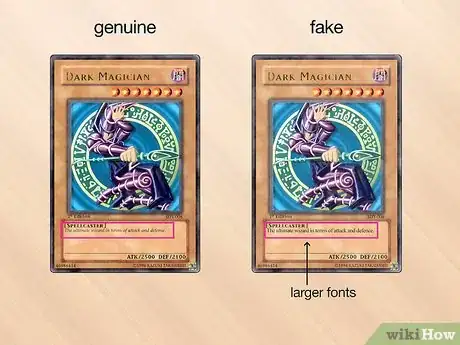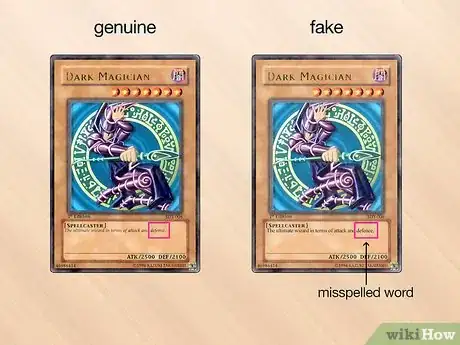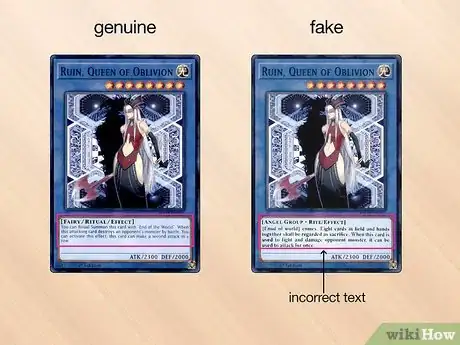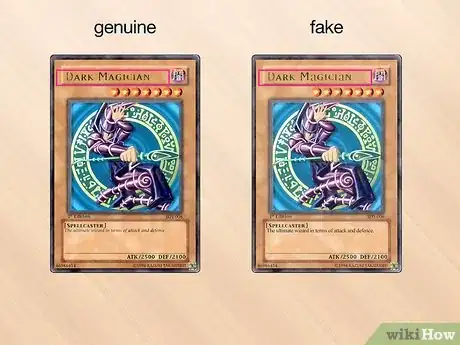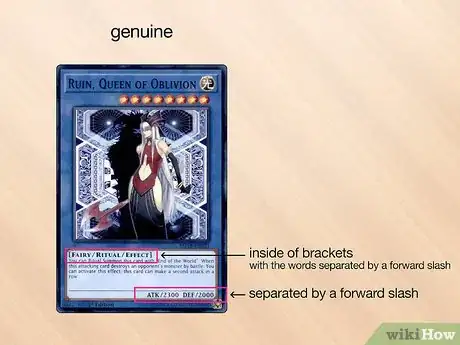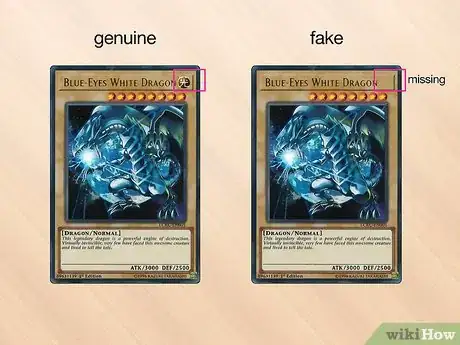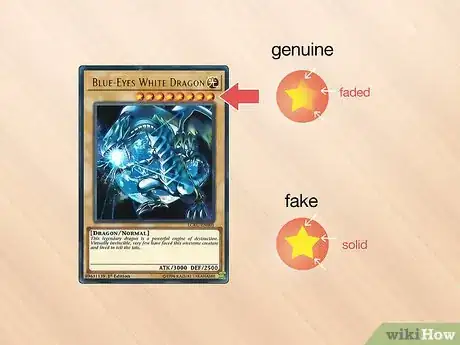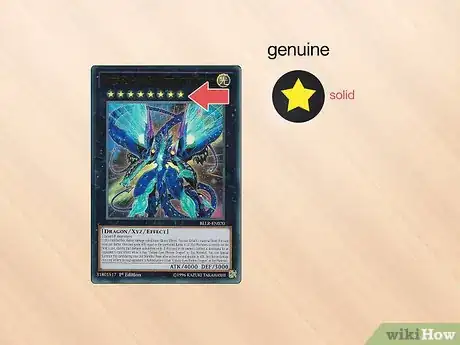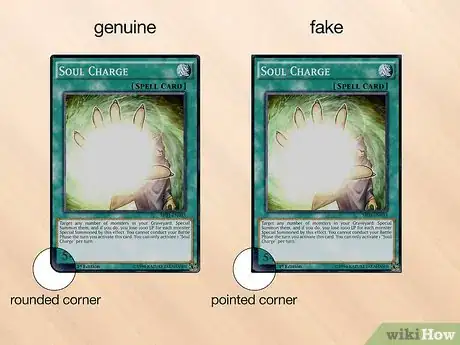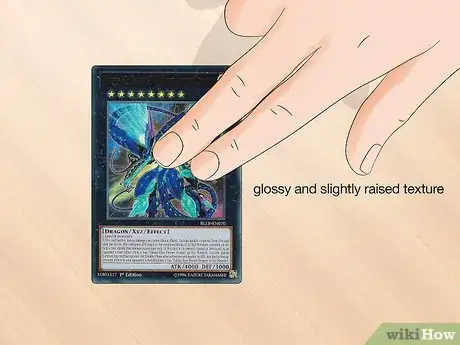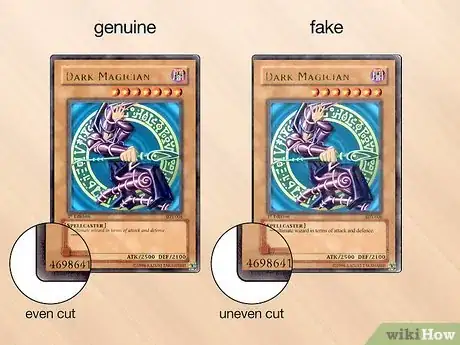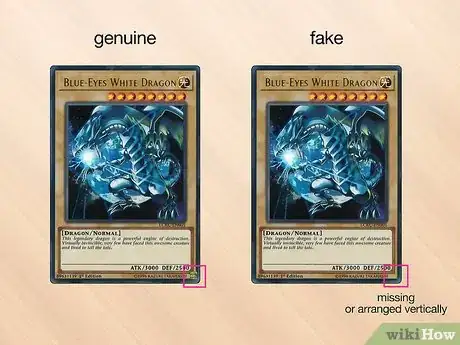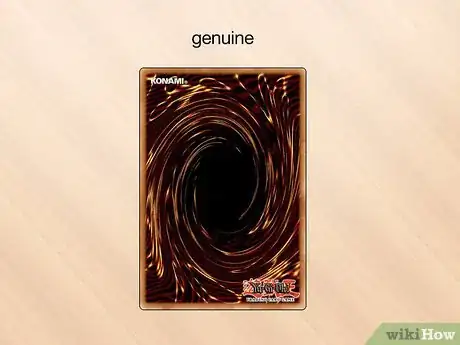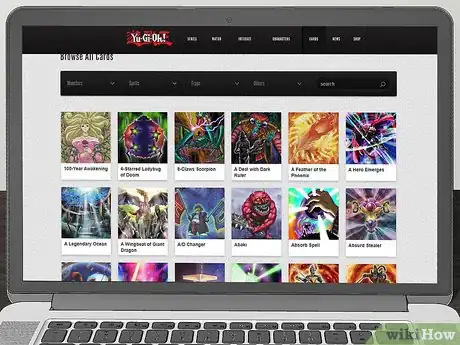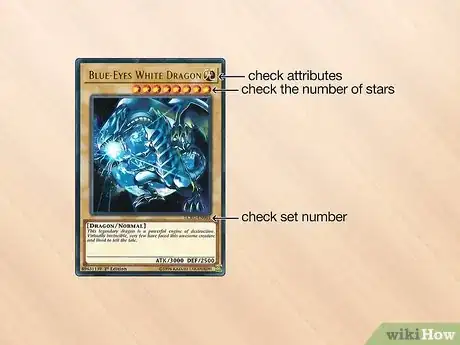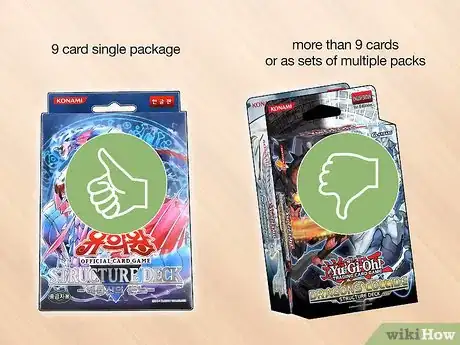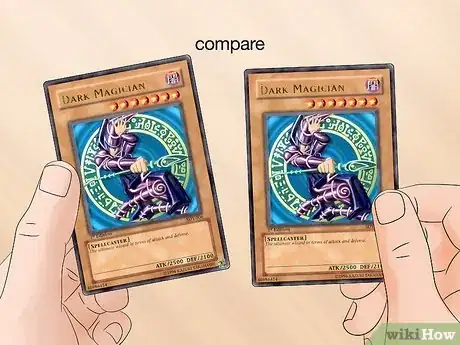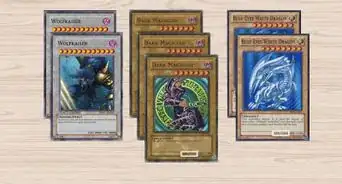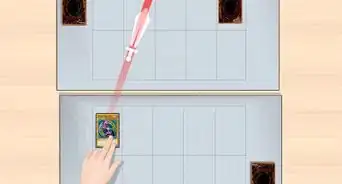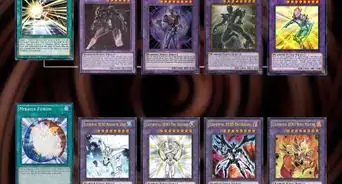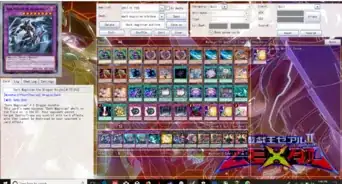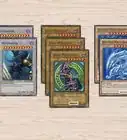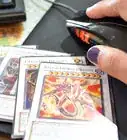This article was co-authored by wikiHow Staff. Our trained team of editors and researchers validate articles for accuracy and comprehensiveness. wikiHow's Content Management Team carefully monitors the work from our editorial staff to ensure that each article is backed by trusted research and meets our high quality standards.
There are 7 references cited in this article, which can be found at the bottom of the page.
wikiHow marks an article as reader-approved once it receives enough positive feedback. In this case, 88% of readers who voted found the article helpful, earning it our reader-approved status.
This article has been viewed 479,821 times.
Learn more...
Identifying fake Yu Gi Oh! cards may seem like it’s difficult, but there are often many tell-tale signs of a counterfeit. Before you purchase any cards, do some research into the stats and features of the cards so you can be sure you’re getting the real thing. The font of the text is often a clue that the card isn’t genuine, as are inconsistencies in the design. Also, be sure to check the symbols to make sure they’re correct and in the right locations. When in doubt, compare the cards to a genuine version to spot differences.
Steps
Checking the Text
-
1Look at the font of the text. Bootleg or fake Yu Gi Oh! cards often have a different font than the real cards. Compare all of the text on the card to a real card to see if there are differences.[1]
- The text on a fake card may also be a larger sized font than on a real card.
Tip: Use any other authentic card to compare the fonts for differences. If you don’t have a card on hand, look up a genuine card online.
-
2See if there are spelling or grammatical errors in the effect text. Fake cards are often mistranslated or the text is poorly spelled. Check the effect text, or the text that describes the abilities and uses of the card, for any misspelled words or awkward syntax for signs that the card is fake.[2]
- Check the way the text is arranged on the card as well. If it looks different than the authentic card, then the card is a counterfeit.
Advertisement -
3Confirm that the effect text is correct. Compare the effect text to an authentic version of the card to see if the text is different. Any changes in wording or phrasing means that the card is fake.[3]
- Look up the card online so you can see the correct text for comparison.
- If the effect text is in italics on the authentic card but it isn’t in the card you bought or plan to buy, then the card is fake.
-
4Check for lowercase letters in a card name. All genuine Yu Gi Oh! cards feature the names of the monster or ability in all caps. If any of the letters in the name are lowercase, then the card is a counterfeit.[4]
- The effect text will have lower case letters, but the card name will not.
-
5Inspect the brackets and slashes to make sure they’re correct. The card names will always be inside of brackets with the words separated by a forward slash. Additionally, the attack (ATK) and defense (DEF) numbers are always separated by a forward slash.[5]
- Check the spacing as well. Some fake cards will have an extra space before or after the forward slashes.
Finding the Symbols
-
1Inspect the attribute symbol at the top right of the card. The attribute symbol is a Japanese character that should be placed at the top right corner of the card. Above the Japanese character, there should be the English translation overlayed on the symbol. If the symbol is missing, the English translation is incorrect, or the translation is misspelled, then the card is fake.[6]
- The list of possible English translations are: light, dark, fire, water, earth, wind, divine, spell, and trap.
Tip: Some older cards may say magic instead of spell.
-
2Check the top, right, and bottom right points of the level stars. Monster cards will have stars that indicate the level of the card. Level cards are a 5-point yellow star with a red-orange circle around it. The top, right, and bottom right points of the level star should be faded or obscured in the red-orange background. If the stars are solid or different, then the card is a counterfeit.[7]
- Compare the alignment of the level stars with another genuine card. Some counterfeits will misalign the level stars.
-
3Observe the features of the rank stars. The rank stars are a yellow 5-point star with a black circle surrounding it. This star should not have any of the points faded or obscured in the background. If the rank star looks different, then the card is fake.[8]
- Rank stars only appear on Xyz monsters. If they’re on another monster card, then that card is fake.
-
4Make sure Spell and Trap cards don’t have any stars. Spell and Trap cards are commonly counterfeited, but you can spot fakes by making sure all of the features of the card are correct. For instance, there should not be any rank or level stars on them.[9]
Looking at the Design of the Card
-
1Look for rounded corners on the card. All genuine Yu Gi Oh! cards feature rounded edges at the corners of the card. If the card has pointed or angled corners, then it’s a counterfeit card.[10]
- Be wary of cards that have corners that are rounded off too much as well.
-
2Feel the surface of the card with your finger to check the texture. The texture of the surface of the card should feel glossy and slightly raised to reflect the features in the art. Rub the surface of the card with your fingertip to feel the texture of it. Fake cards are often flat and rough.[11]
- Fake cards may feel like sandpaper when you rub it.
-
3Check to see if the borders of the card are miscut. A major tell-tale sign of a fake card are borders on either the front or back of the card that aren’t even and consistent. It’s a sign that the card was miscut and is a counterfeit.[12]
- Make sure you check both the front and back of the card for an uneven border.
-
4Inspect the foil stamp in the bottom right corner of the card. Authentic cards will have a shiny, square stamp on the bottom right corner of the front of the card with the words “Yu-Gi-Oh!” in small, horizontal script. Fake cards may be missing the foil stamp or the letters may be arranged vertically.[13]
- The color of the foil should be either gold or silver. Any other color is a counterfeit.
Tip: Gold colored foil indicates that the card is a first edition or a limited edition. If the card is labeled or sold as a first or limited edition and it has a silver foil stamp, then it’s a fake.
-
5Confirm the design, logo, and trademark on the back of the card are correct. The back of the card should have a dark orange swirl with a black oval in the center. On the bottom right hand corner there should be the official Yu Gi Oh! logo. It should also say “trading card game” with a trademark symbol.[14]
- If any of the features are missing or in the wrong location, then the card is fake.
- The border on the back of the card should be slightly thicker than the border on the front of the card as well.
Using Good Buying Practices
-
1Research the cards you plan to purchase. Whenever you plan to buy Yu Gi Oh! cards you need to know all of their traits and stats so you can be sure you purchase authentic cards. Visit the official Yu Gi Oh! website so you can be sure you have accurate information.[15]
- Go to https://www.yugioh.com/ to find information about the cards you’re looking to buy.
Tip: Check online forums for information about the cards and what counterfeit versions may look like.
-
2Check the name and stats of the cards you buy. Even if you buy your cards from a major retail store or the packaging is sealed, you can’t necessarily trust that they’re authentic. You need confirm the cards are genuine by making sure that the card is correctly named and contains the real stats.[16]
- The stats include the attributes as well as the level or rank.
- Also compare the set numbers listed beneath the lower right corner of the picture of the card to the set numbers of an authentic version of the card.
-
3Avoid cards sold in sets of multiple packs of cards. Unopened sets of Yu Gi Oh! cards come in a 9 card single package. Counterfeit cards are often sold in packages containing more than 9 cards or as sets of multiple packs.[17]
- Sets of 3 packs for discounted prices are dead giveaways that the cards are fake.
-
4Compare 2 of the same cards to spot differences. Whether you plan to buy cards from a person online or in-person, you need to compare the cards they’re selling to authentic versions so you can look for any differences. If the cards that they’re trying to sell you have any differences, then they’re fake.[18]
- Look up the real version of the card online so you can compare it to the cards being sold.
Community Q&A
-
QuestionWould a card with no serial number and a notation on the bottom saying "first edition" be real or fake?
 Community AnswerIt depends - some cards like the Egyptian God Cards (Slifer The Sky Dragon, Obelisk The Tormentor, The Winged Dragon of Ra, The Winged Dragon of Ra - Sphere Mode, The Winged Dragon of Ra - Immortal Phoenix) do not have serial numbers. This goes for the collectible and playable versions of the Egyptian God Cards. But if it's a card like Blue-Eyes White Dragon, it most likely is fake. Other cards that don't have a serial number include Black Luster Soldier (Ritual monster), Five-Headed Dragon, etc. This does not mean they're fake. Sometimes cards are accidentally printed without serial numbers and are misprints.
Community AnswerIt depends - some cards like the Egyptian God Cards (Slifer The Sky Dragon, Obelisk The Tormentor, The Winged Dragon of Ra, The Winged Dragon of Ra - Sphere Mode, The Winged Dragon of Ra - Immortal Phoenix) do not have serial numbers. This goes for the collectible and playable versions of the Egyptian God Cards. But if it's a card like Blue-Eyes White Dragon, it most likely is fake. Other cards that don't have a serial number include Black Luster Soldier (Ritual monster), Five-Headed Dragon, etc. This does not mean they're fake. Sometimes cards are accidentally printed without serial numbers and are misprints. -
QuestionIf a card has a silver holographic square and says first edition or limited edition, is it fake?
 Community AnswerYes. KONAMI pays a lot of attention to the cards (very rarely, they have typos), but every limited and first edition card always has a gold square.
Community AnswerYes. KONAMI pays a lot of attention to the cards (very rarely, they have typos), but every limited and first edition card always has a gold square. -
QuestionHow do I make a strong Yu Gi Oh deck?
 Community AnswerUse cards that work well together and devise a strategy or buy a structure deck. Structure decks usually have good cards that work together.
Community AnswerUse cards that work well together and devise a strategy or buy a structure deck. Structure decks usually have good cards that work together.
References
- ↑ https://youtu.be/I2Q6yGuuTQ8?t=156
- ↑ https://youtu.be/I2Q6yGuuTQ8?t=581
- ↑ https://youtu.be/I2Q6yGuuTQ8?t=581
- ↑ https://www.yugiohcardguide.com/fake-yugioh-cards/
- ↑ https://www.yugiohcardguide.com/fake-yugioh-cards/
- ↑ https://www.yugiohcardguide.com/fake-yugioh-cards/
- ↑ https://www.yugiohcardguide.com/fake-yugioh-cards/
- ↑ https://www.yugiohcardguide.com/fake-yugioh-cards/
- ↑ https://www.yugiohcardguide.com/fake-yugioh-cards/
- ↑ https://www.yugiohcardguide.com/fake-yugioh-cards/
- ↑ https://youtu.be/I2Q6yGuuTQ8?t=91
- ↑ https://youtu.be/I2Q6yGuuTQ8?t=117
- ↑ https://www.laweekly.com/are-your-yu-gi-oh-cards-bogus-how-to-tell-the-real-ones-from-the-fakes/
- ↑ https://www.yugiohcardguide.com/fake-yugioh-cards/
- ↑ https://www.yugiohcardguide.com/fake-yugioh-cards/
- ↑ https://www.yugiohcardguide.com/fake-yugioh-cards/
- ↑ https://www.laweekly.com/are-your-yu-gi-oh-cards-bogus-how-to-tell-the-real-ones-from-the-fakes/
- ↑ https://yugioh.fandom.com/wiki/Counterfeit
